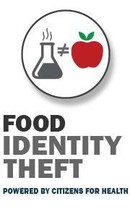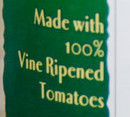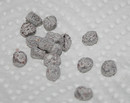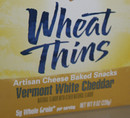 What is Food Identity Theft?
What is Food Identity Theft?
FoodIdentityTheft.com is a website that alerts consumers about threats to the food we buy for ourselves and our families. The website is sponsored by Citizens for Health, a non-profit consumer action group that has been around for almost 20 years and has more than 100,000 followers. The Food Identity Theft Project for Citizens for Health believes Americans have the right to know what ingredients are in the food products they consume.
FoodIdentityTheft.com provides important facts to consumers about food safety issues, as well as ways to connect with Congress and government regulators to express their opinions and concerns about truthful food policies.
More and more, consumers are being deceived by big corporations that are more concerned with their profits that our health. From breakfast cereals and muffin mixes that call themselves “Blueberry” but contain absolutely no blueberries, to blatantly deceptive food labeling practices, some food companies are trying to steal consumers’ rights to know what’s in the foods they’re buying and consuming.
The High Fructose Corn Syrup Name Game is the first major issue FoodIdentityTheft.com is taking on. The Corn Refiners are trying to deceive American consumers by trying to change the name of High Fructose Corn Syrup (a widely-used man-made sweetener) to “corn sugar.”
In the coming months, FoodIdentityTheft.com will target other food manufacturers that mislabel their products in order to mislead consumers into thinking they’re buying something they’re not. From “whole wheat” crackers that are primarily made from processed and refined white flour, to “fresh tomato sauce” that’s actually made from industrial tomato concentrate, consumers are being regularly duped by deceptive practices.
![10. Godiva Chocolate Bar with Raspberries image]() 10. Godiva Chocolate Bar with Raspberries
10. Godiva Chocolate Bar with Raspberries
A class act it’s not: GODIVA Chocolatier Dark Chocolate filled with Raspberry
We’ve all been hearing how good dark chocolate is for you, and who out there doesn’t know the Godiva name means top of the line – especially given its luxury price tag of $2.95 for a 1.5-ounce single-serving bar. But this super-premium confection (made by “chocolatiers” no less) contains both high fructose corn syrup (HFCS) and the preservative sodium benzoate. No less an authority than Dr. Andrew Weil refers to HFCS as a “cheap sweetener” and a “marker for low-quality food” — certainly not the sort of ingredient Godiva founder Joseph Draps would have used in the products sold in his Belgian chocolate shop in 1926.
 9. Funny Honey
9. Funny Honey
The sweet nectar of the bees, honey is one of the world’s oldest sweeteners. The trouble is, over 75 percent of the “honey” being sold in stores in the U.S. really isn’t. Tests done for Food Safety News revealed that most of the honey you find in the supermarket contains no pollen, and without pollen, it’s impossible to tell if the honey came from “legitimate or safe sources.” This ultra-filtered honey is most likely from China and what ‘extras’ it may contains is anyone’s guess.
![8. Orange Ya' Sad? image]() 8. Orange Ya’ Sad?
8. Orange Ya’ Sad?
Once upon a time, it came from an orange. Pasteurized, stripped of oxygen and dumped in million-gallon storage tanks where it sits for up to a year, and then revitalized with flavor packets containing secret ingredients, your “premium” orange juice has really been through quite a ‘squeeze’ by the time it reaches your breakfast table. In fact, we’re not even sure it deserves to be called “orange juice “any more. Despite the 100 percent pure claims and pretty photos of juicy oranges, the “not from concentrate” varieties marketed by Tropicana, Minute Maid Florida Natural and other major brands are not what they appear to be.
 7. "Freshly" Reconstituted Tomato Concentrate?
7. "Freshly" Reconstituted Tomato Concentrate?
Another “fresh” deception. As you may have noticed by now, “fresh” is a very popular labeling term, and too often just not true. Such is the case with numerous canned tomato products that tout “made with 100% vine ripened tomatoes” or “made from fresh tomatoes.” If an ingredient check shows tomato paste, the sauce was reconstituted from industrial tomato concentrate, and can hardly be called “fresh.” Another case where you have to read the ingredient listings, not the label claims.
![]() 6. "Fruity" Fruit Cereal
6. "Fruity" Fruit Cereal
A case of fruit identity theft. Searching for the fruit in numerous fruity products can be a fruitless challenge. From Kellogg’s Froot Loops, Post brand Fruity Pebbles, to General Mills’ Fruit Roll-Ups, these fruit-labeled products contain plenty of artificial colors and flavors to look like fruit, but what’s missing is the real thing. Recently the Center for Science in the Public Interest filed a complaint against General Mills for its deceptive “fruit” products, accusing them of “misleading and deceptive advertising and fraudulent business practices.” The take away? Once again, reading the ingredient list is the only way to find out if you’re actually getting what you think you are.
 5. Bogus Blueberries!
5. Bogus Blueberries!
Beware of bogus “blueberries”. Everyone loves blueberries. They are a super-antioxidant fruit that taste great. Food manufactures love blueberries too, or should I say, they love the idea of blueberries. To uncover this culinary chicanery you don’t need to be Sherlock Holmes — just check the ingredient panel on numerous “blueberry” foods and you’ll find ingredients such as “blueberry-flavored fruit pieces” or artificial flavors and blue colors, but nary a blueberry. Our favorite blueberry not foods are the Jiffy brand blueberry muffin mix and ShopRite instant oatmeal with “blueberries & cream.”
![4. Trans fat FREE? Not quite... image]() 4. Trans fat FREE? Not quite…
4. Trans fat FREE? Not quite…
Trans fats are recognized as a major contributor to heart disease – but you probably knew that already, didn’t you? And you most likely check that handy nutrition facts label to make sure the processed foods you’re buying contain no trans fats. Like so many other moves by the U.S. Food and Drug Administration, the trans fat labeling requirement that went into effect in 2006 falls way short of providing consumers easy help in choosing trans fat-free foods. If a food product contains less than 0.5 grams of this bad-cholesterol raising ingredient, it can tout 0 trans fats – meaning you can be getting a significant dose of trans fats even if all the products you consume state they have none. Trans fats, which are never the saturated variety, can be found in processed foods such as crackers, cookies, breads and fast foods, in the form of a cheap shortening that also gives products a longer shelf life. So how can you avoid trans fats in your diet? Once again, read the ingredient label. If a product contains any partially hydrogenated oil, put it back on the shelf, even if the nutrition label says it’s trans fat free.
 3. Whole Grain Not Whole Truth
3. Whole Grain Not Whole Truth
The “whole grain” claim that isn’t the whole truth. Many breads, cereals, crackers and even some cookies shout “WHOLE GRAIN” at us on their packaging. Some even list the grams of whole grain in big letters, and some use the word “wheat” in the name of the product, but what does it all mean? Whole grains include grains such as wheat, corn, rice, oats, barley, quinoa, sorghum, spelt and rye, but only when they are eaten in their whole form. If a product is made with “enriched flour,” even if it specifies “wheat flour,” that is not a whole grain. Here’s where it get even trickier; while a product may claim it “contains” or is “made with” whole grain, unless the word “whole” (such as whole wheat flour or whole oats) is listed among the first ingredient, chances are it’s just a tiny bit added to justify the claim. The Whole Grains Counsel, which maintains a web site devoted to this issue, says we should be eating around 48g per day. For some examples, one slice of 100 percent whole wheat bread provides approximately 22g of whole grains, whereas a serving of Ritz Simply Socials “golden wheat” gives you only 5g of whole grain. Another product with a misleading name, Nabisco’s Wheat Thins, also only provides 5g per serving. So if you’re looking for whole grains, once again, look to the ingredient list, not the product name or claim.
![2. MSG by Any Other Name Isn’t “NO MSG” image]() 2. MSG by Any Other Name Isn’t “NO MSG”
2. MSG by Any Other Name Isn’t “NO MSG”
Sneaker than the Grinch stealing Christmas, manufacturers are onto the fact that more and more consumers are trying to avoid monosodium glutamate. But instead of removing it, some companies simply slap labels stating “No MSG,” or “No MSG added” on products with disguised forms of the flavor enhancer. If a food contains the ingredient monosodium glutamate, that fact must be stated on the label. However, monosodium glutamate is only one of many ingredients that contain “free” glutamate. There are numerous others, including yeast extract; anything “hydrolyzed;” autolyzed yeast; soy protein concentrate and whey protein isolate. Another sneaky tactic is to state that the MSG, from whatever source, is “naturally occurring.” Don’t believe it. “Naturally occurring” is never defined, and the free glutamate, whether found in monosodium glutamate or in any other ingredient was deliberately added for the purpose of making the product taste better. It didn’t get there by accident.
 1. The Great “Corn Sugar” Scam
1. The Great “Corn Sugar” Scam
Without further ado, our pick for the top food labeling deception scheme, for the most glaring example of the food industry attempting to scam the public is the Corn Refiners Association’s plan to rename high fructose corn syrup – an ingredient with a serious image problem – to the innocuous-sounding “corn sugar.” Aside from being an obvious trick to try and sidestep the fact that an untold number of consumers are avoiding products that contain HFCS, the strategy is an attempted case of “ingredient identity theft,” since “corn sugar” already exists as a totally different product that contains NO fructose! Now how, you might ask, can it be that they would try to rip off an existing name in so devious a manner? Well, it be, and it’s up to you, as a savvy and not easily fooled consumer to tell the FDA you won’t stand for such nonsense – by adding your comments to a rising tide of consumer objections to the CRA’s petition to rebrand this chemical-concoction sweetener that have been submitted to the agency.






You’ve got a great blog here! would you like to produce some invite posts on my website?
Are you trying to contact Linda Bonvie? She is at http://foodidentitytheft.com/blog/. Thank you for your inquiry!